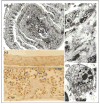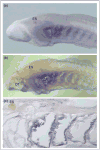Evolution and development of immunological structures in the lamprey
- PMID: 17875388
- PMCID: PMC2093943
- DOI: 10.1016/j.coi.2007.08.003
Evolution and development of immunological structures in the lamprey
Abstract
Comparative immunology has been revitalized by the integration of genomics approaches, which allow a foothold into addressing problems that previously had been difficult to study. One such problem had been the enigmatic finding of overt immune anatomical structures in the lamprey, yet its apparent lack of bona fide immunoglobulin or T cell receptor molecules. The genomic characterization of a novel extended locus that undergoes rearrangements to generate receptor diversity and the subsequent implementation of this diversity in the immune system of lampreys have generated considerable interest as well as new avenues for investigation. Here, we review the anatomical structures of the lamprey that exhibit lympho-hematopoietic characteristics, with the ultimate goal of reconciling these data with contemporary molecular findings. By integrating these datasets we seek to better understand how an alternative adaptive immune system could have evolved.
Figures



References
-
- Du Pasquier L, Flajnik M. Origin and evolution of the vertebrate immune system. In: Paul WE, editor. Fundamental Immunology. 3. Raven Press, Ltd; 1998. pp. 199–233.
-
- Alder MN, Rogozin IB, Iyer LM, Glazko GV, Cooper MD, Pancer Z. Diversity and function of adaptive immune receptors in a jawless vertebrate. Science. 2005;310:1970–1973. - PubMed
-
This is the second lamprey VLR paper to be published. The study made extensive use of rearrangement ‘intermediates’ for inferring that the locus may undergo rearrangement via some sort of gene-conversion mechanism. They also used computational analysis of sequences of existing VLR components, mature VLRs, and the transcriptome, to infer a staggering level of diversity of VLRs that could be generated. This study also showed that the lamprey can use their VLRs for specific recognition of particulate and soluble protein antigens in a humoral response.
-
- Pancer Z, Amemiya CT, Ehrhardt GRA, Ceitlin J, Gartland GL, Cooper MD. Somatic diversification of variable lymphocyte receptors in the agnathan sea lamprey. Nature. 2004;430:174–180. - PubMed
-
This is the original lamprey VLR paper. A series of cDNAs had been identified that contained variable numbers of different LRR cassettes but whose 5′ and 3′ regions were absolutely conserved. It was inferred that this molecule, named variable lymphocyte receptor, could be a surrogate immune recognition molecule analogous to Ig. The researchers used long-range sequencing of the VLR locus to show that the locus is not complete and that the components of complete form of the VLR gene were outside of the locus so that genomic rearrangement was necessary to make an intact gene. They could show that rearrangement occurred at the genomic level and specifically in lymphoid cells, not erythrocytes. In addition, the authors performed single cell PCR to show that VLRs are generated in a monoclonal fashion.
-
- Pollara B, Litman GW, Finstad J, Howell J, Good RA. The evolution of the immune response. VII. Antibody to human “O” cells and properties of the immunoglobulin in lamprey. J Immunol. 1970;105:738–745. - PubMed
-
- Good RA, Finstad J, Litman GW. Immunology. In: Hardesty MW, Potter IC, editors. The Biology of Lampreys. London: Academic Press; 1972. pp. 405–432.
Publication types
MeSH terms
Substances
Grants and funding
LinkOut - more resources
Full Text Sources
Medical

